1. Entry page:
About the Statbank
Here you’ll find information about update times in the Statbank and links to various help pages.
Search in the Statbank
Currently, you can only search by table names and variable headings. Eventually, it will be possible to search within the content of the variables.

Filtering
The entry page shows the most recently updated tables, with filters on the left. Above the table list, you’ll see how many tables match your criteria. Up to 15 tables are shown on the first page. If there are more matches, a “Show more” button appears at the bottom of the list.
Filters include:
- Topic (main and subtopics)
- Year (from–to)
- Time period (year, quarter, month, week)
- Variable (e.g., region, age, industry)
- Status (whether tables will be updated or not)
Each filter offers multiple options. Depending on your selections, the table list will change. You’ll always see how many tables match each filter option.
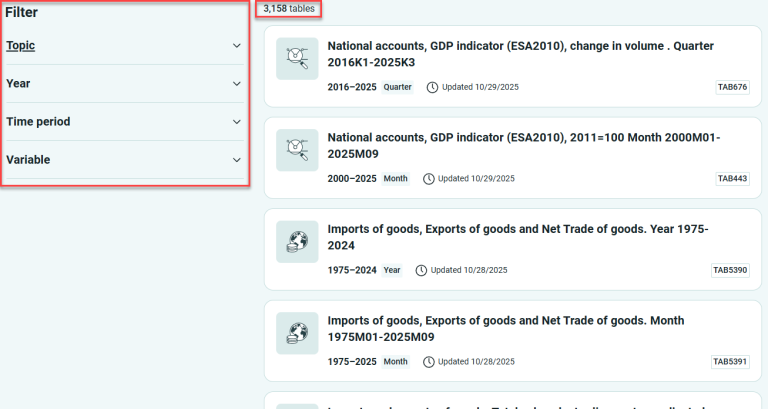
Tips for using filters:
It’s often useful to filter by Status first to narrow down the number of tables:
- Open Status filter with “Updated” selected. You can also choose “No longer updated.”
- If you select the main topic “Labour and wages,” you’ll see that 360 tables are updated. You can then choose a subtopic – in this case, there are four.
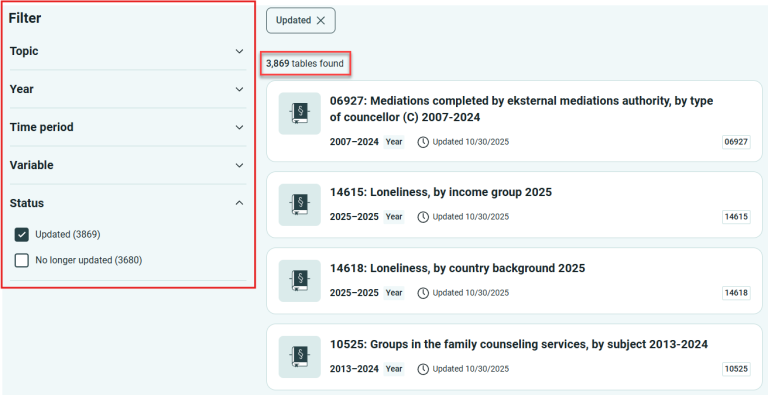
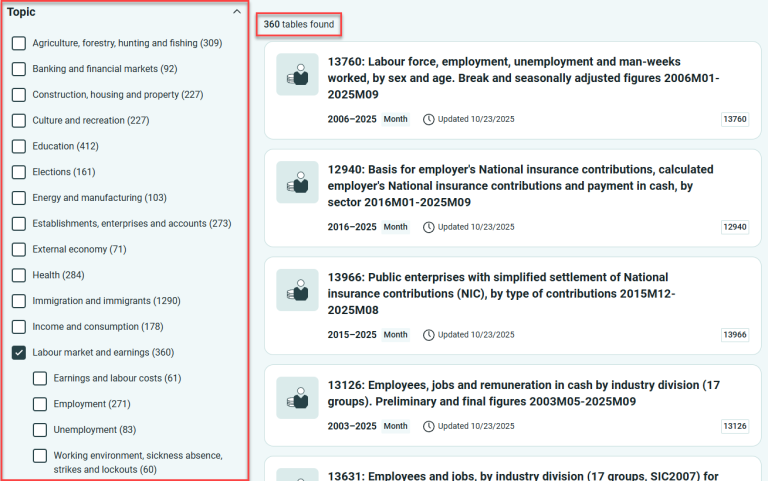
If you don’t select anything under Status, you’ll get many more tables.

Tables that are updated are shown in green, while those that are not are shown in red.

Selecting multiple main topics can quickly become overwhelming. If you want to switch from one main topic to another, remember to deselect the previous one.
The Variable filter includes classification variables, but not contents variables (i.e., what is measured or counted). Selecting multiple variables will return tables that include all selected variables. This helps narrow down the results quickly. The list is sorted by number of matches, and variables with no matches will disappear as you make new filter selections.
Above the result list, you’ll see the filters and search terms you’ve used. You can easily remove one or more selections to adjust your search. These filter choices are also reflected in the URL.
2. Table page:
Initial view of the table page
The table page is divided into three sections. On the far left, there are five buttons:
- Filter
- Display
- Edit
- Save
- Help
The table you see is generated by an algorithm and will change immediately when you select something under Filter. Filter is the default and appears open.
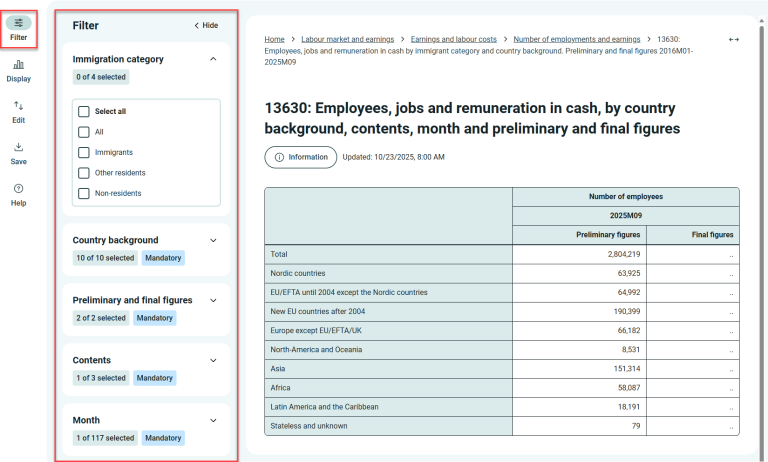
Example:
Several selections have been made – three under Immigration category and one extra month. The table has changed accordingly.
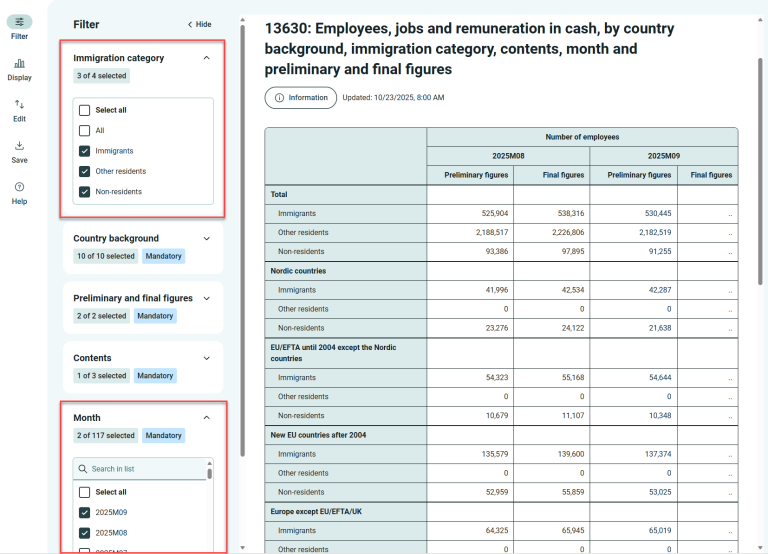
The more selections you make, the wider the table becomes. To view more of the table at once, click “Hide” and the arrows in the top right corner of the window.

Some variables have multiple levels. Under Country background, you can choose between “8 world regions” and “Selected countries.”
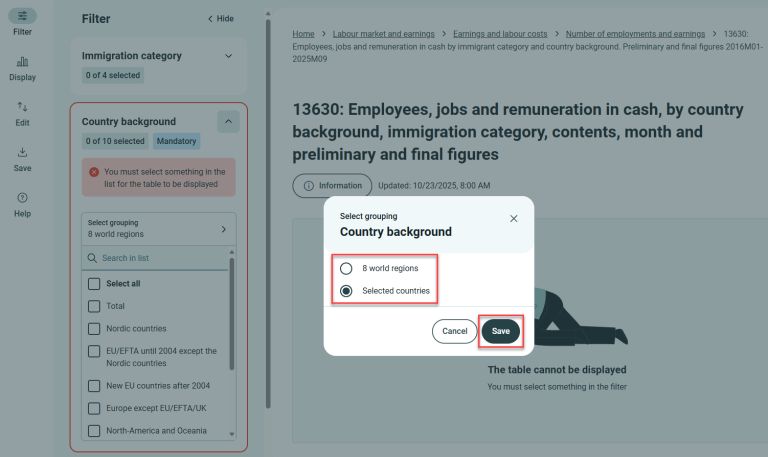
When switching to a new classification, the first value is often selected by default. Deselect it if you prefer others. In long value lists, there’s a search function. Search for and select the countries you want. Click the “X” in the search field to return to the list of selected countries.
Example:
Search for Denmark under Selected countries.
Now 6 countries are selected.
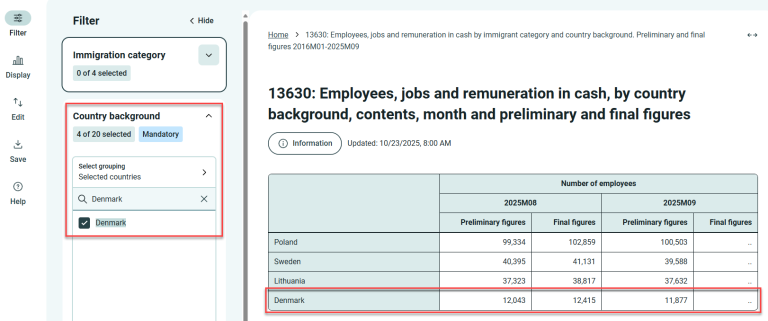
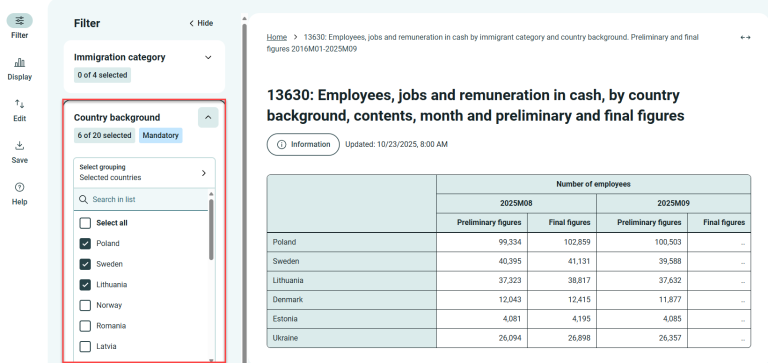
Search in long lists
-
If the selection box (variable) contains many values, you will find a search field labeled “Search in list” at the top of the box.
-
If “Select all” is checked and you don’t need all the values, click “Select all” and you will see that the selections are cleared.
-
Search for what you want and check the items you want to include in the table.
-
Repeat the search until you have selected all the values you need.
-
When you search for a word, only the matching results will be displayed. Remove the search term if you want to search the entire list again.
-
A new search does not automatically remove previously selected values.
-
If you want to start over, click “Select all” twice, and all selections will be cleared.
-
The search field applies to the list of possible choices, not the table itself. If you want to search within the table, you can use Ctrl+F.
Information
The “Information” button provides:
-
Notes (before footnotes) and symbol explanations
-
Definitions (links to variable definitions, classification standards, and About the statistics will be added)
-
Table details (e.g., update date, unit of measurement, reference time)
-
Contact persons for the table
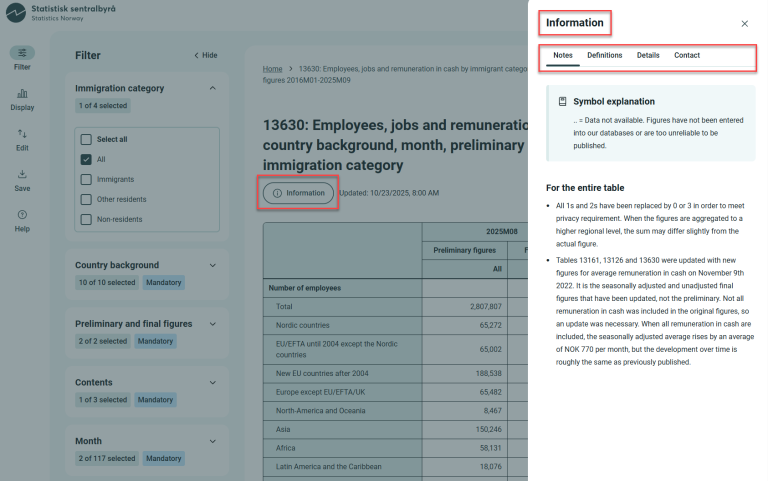
Display
Graph display is under development.
Edit
Currently, “Rotate table” is the only tool available.

Sometimes the table becomes easier to read if you switch rows and columns (not in this example). You can rotate the table multiple times until you’re satisfied.
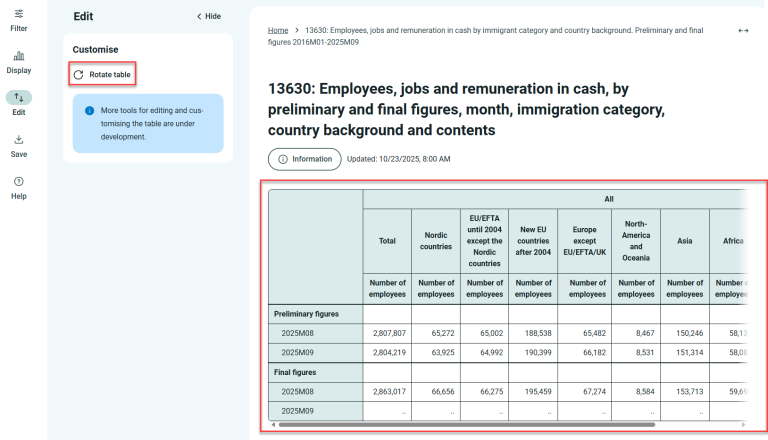
A better rotation function will be available soon.
Save
You can save the finished table as a file. Available formats:
- Excel (.xlsx)
- Semicolon-separated with header (.csv)
- PC-Axis (.px)
- JSON-stat2 (.json)
- HTML (.html)
- Parquet (.parquet)
If the extract contains more than 200,000 cells, saving as Excel may be problematic. Choose another format in that case.
If cells show dates instead of numbers when opening a CSV file in Excel, the file itself is fine. This is due to Excel’s automatic date conversion. We recommend saving as Excel if you want to use Excel. Otherwise, in Excel, use “Data” → “From text/CSV” instead of double-clicking the file.
Link to Updated Table
You’ll get a unique link to your table, which we keep updated for you. You choose how new time periods are added:
-
Don’t add new (table will only show your current selections)
-
Add new (new periods will be added to your current selections)
-
Add new, but keep same number (new period added, oldest removed)
After making your selections, you’ll get a unique link based on your choices. If you make changes, a new link is created.
“Saved query” is not intended for automation. For that, use the API. If you make too many requests in a short time, you’ll get a warning (429 error). Users who request many saved queries at 08:00 may have their IP address blocked.
API Query
API query functionality is under development.